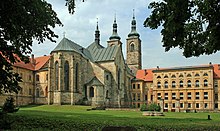Norbertine Rite

The Premonstratensian Rite or Norbertine Rite is the
History
The Norbertine rite ("Norbertine" is another name for the Premonstratensians) differs from the Roman Rite in the celebration of Mass, the Liturgy of the Hours and the administration of the Sacrament of Penance.
Its liturgical books were reprinted by order of the general chapter held at Prémontré in 1738. A new edition of the Missal and the Breviary was issued after the General Chapter of Prague, in 1890. In 1902 a committee was appointed to revise the Gradual, Antiphonary etc. and was encouraged by the motu proprio of Pope Pius X on church music. The General Chapter of Tepla, Austria, in 1908, decided to edit the musical books of the order as prepared, in accordance with ancient manuscripts by this committee.
Mass
The Premonstratensian Missal was not arranged like the Roman Missal. While the canon was identical, with the exception of a slight variation as to the time of making the sign of the cross with the paten at the "Libera nos", the music for the Prefaces etcetera differed, though not considerably, from that of the Roman Missal. Two alleluias were said after the "Ite missa est" for a week after Easter; for the whole of the remaining Paschal time one alleluia was said.
A full account of the Premonstratensian rite of Mass, as it was before the Second Vatican Council can be found at The Premonstratensian Rite, which reproduces the text of Chapter Three in Liturgies of the Religious Orders by Archdale King (Bruce Publishing Company, Milwaukee, Wisconsin, U.S.A.; 1953).
Liturgy of the Hours
The Norbertine
Besides the daily recitation of the
Administration of the Sacrament of Penance
The form of absolution differed from the Roman Ritual. The following was the Norbertine formula: "Dominus noster Jesus Christus te absolvat, et ego auctoritate ipsius, mihi licet indignissimo concessa, absolvo te in primis, a vinculo excommunicationis ... in quantum possum et indiges", etc.
